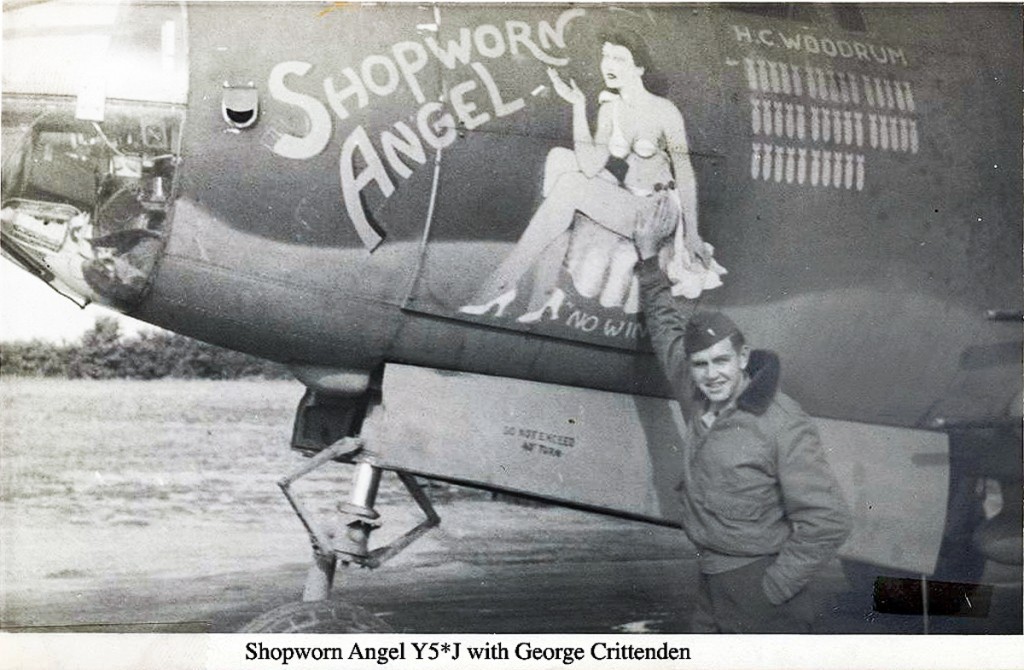Night Bombing George Crittenden
The following is an e-mail from George Crittenden. He was the bombardier of B-26, Sexy Sal. He was good enough to compose and send me the description of an experiment in night bombing that he took part in. I couldn’t even find a single reference to this when I “googled” it! This is why it is so important to get first hand stories while we still can!
Thanks George!
Carl
On March1, 20l0 I sent you a message about my name being on the roster of the 495th BG and included a reference to flying some night missions. I thought you might be interested in more details about those missions.
A problem facing those in command was how to disrupt repairs the Germans were making to rail yards at night after being bombed earlier in the day. The British were more inclined to “area” bombing rather than pinpoint bombing as used by the USAC.
Trying to use formation bombing at night was not an option. Instead, a program was developed, using A-20s, A-26s, and B-26s to allow night time, pinpoint bombing. For some reason my crew was assigned to the newly formed outfit to carry out the program.
Each plane was on its own from takeoff to return, no formations.
To make the planes as difficult as possible to see, they were painted a dull black, including any identification makings. Exhaust pipes had flame dampeners, the plane made to be as much total blackouts as possible.
The backbone of the program was for each plane to fly individually to the target area arriving at a precise time, at scheduled altitude, traveling in a prescribed direction,at proper speed. I do not remember just how much practice we were allowed but the procedure was to fly from base in random directions. At a different time turn around and navigate our way back – via G-Box to arrive back at Base exactly at the time prescribed earlier…..by exact I mean within 15 to 30 seconds
Here is how those missions were laid out:
The first planes to the target area were two B-26s flying at the same speed, altitude, and direction but flying one mile apart, horizontally, with the target area in between them. Remember they could not see each other. At the precise time they would drop a string of white flares (Their job was now over and they went home). Next an A-26 would fly between the flares dropping a colored flare on the aiming point, retreating to a higher altitude to be out of the way of the A-20s.
The A-20s came in in group of three planes each on the same course and few seconds behind each other and flying at staggered altitudes. After each had dropped its bombs individually they were free to head for home. They would be followed on the bombing run be another group of three doing the same thing and followed by more groups of three until white flares began to burn out. Another pair of B-26s would show up and drop their white flares the same as the earlier two, again the A-26 would descend and drop another colored flare on the aiming point followed by more A-20s performing as the A-20s before them. As good as my memory can be after 66 years I think each mission consisted of three parallel rows of white flares and three colored flares before the last of the A-20s arrived.
The absolutely precise flying and timing was imperative. Even though there were no air to air accidents, several planes reported feeling prop wash from time to time! I do not remember just how effective these raids were, but the high command called them off after just a few missions. It was probably a combination of the complexity of getting each and every plane in its proper position at the right time and the questionable effectiveness of the bombs.
Two asides come to mind. On one mission, our plane was caught in ground searchlights for several minutes…friendly searchlights! To maintain our schedule we could not try evasive action but merely had to ride them out. Apparently the searchlight crew had not been informed that we were coming. They soon did get the word as we were the only plane caught in their lights
On another mission there was a recall ordered after the planes were airborn. One A-20 did not receive the order. Everyone else returned to base and hoped he would show up at the time originally set for his return. Right on schedule, he showed up safe and sound. The pilot complained that he did not see any flares or bursting bombs but felt he was in the proper place at the proper time so he dropped his bombs. When he was told that his was the only AEF plane over Europe that night, he as “All Shook Up” and
devoured an extra portion of booze!
I do not know what happened to those “black” planes, but I do know the whole idea of that kind of mission was dropped and never to be heard of again.
Please consider this all happened some 66 years ago and my memory may be a bit vague, but I do think the experience was so unique that my memory of it is probably better than my memory of anything else that occurred 66 years ago!
If in your persuit of information about the air warfare, you come across others that were involved with these night missions, I would like to contact them (please e-mail Carl: damonbok@hotmail.com)
Thank you for spending your time to read through this ambling report.
.



